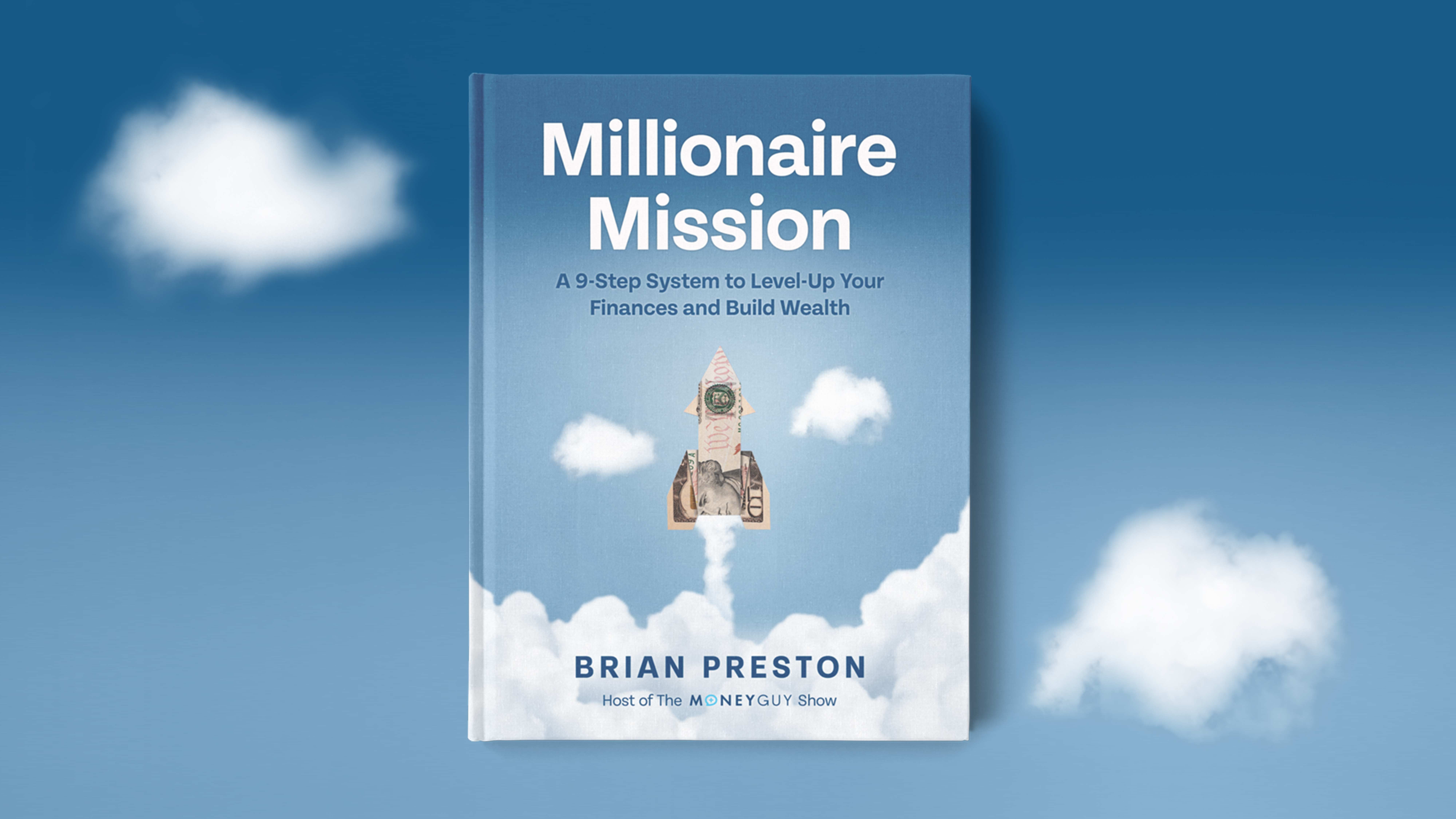
Change your life by
managing your money better.
Subscribe to our free weekly newsletter by entering your email address below.

Subscribe to our free weekly newsletter by entering your email address below.
The Five Stages of Building Wealth
Net worth targets and hard numbers are definitely useful—we use them all the time on The Money Guy Show. However, they aren’t really tailored to your personal situation. That’s why today’s topic focuses on five stages of building wealth that are adaptable to your unique financial journey. We’ll go through what each stage looks like and explore strategies to level up to the next one.
This is where it all begins. You have more money coming in than going out—you’re living on less than you make. Maintaining a consistently positive cash flow is the foundation of financial discipline and the first step toward getting your dollars working for you.
Unfortunately, this is where many Americans get stuck. According to the Aspen Institute, over half of Americans are cash flow neutral or negative, leaving little room to build an emergency fund or long-term wealth.
There are two main levers to pull:
Lowering expenses may involve:
But there’s a limit to how much you can cut—eventually, you hit the bone. That’s when increasing income becomes essential.
Consider:
💡 Avoid lifestyle inflation. As your income grows, keep your expenses steady. The goal is to widen the gap between what you earn and what you spend—creating the “margin” that allows real wealth to grow.
At this stage, you’re building early assets, laying the groundwork before compound interest starts to do the heavy lifting.
Learn more about building positive cash flow
To move from Stage 1, you must save more—and keep saving.
It’s not flashy, but it’s achievable. The focus here is on creating consistent habits that build your foundation.
Key actions:
Explore our guide on prioritizing your savings goals
This is a major milestone—and one that doesn’t get enough attention. It’s when your annual investment returns exceed what you contribute from your own savings.
In other words, your money is officially working harder than you are.
Let’s walk through the math:
That’s 12.5 times your annual savings rate, and it holds true at an 8% return no matter your savings amount.
At this point, you’re seeing real compounding in action. Your patience and discipline are paying off, and market growth begins accelerating your wealth-building journey.
Check out: When Do Your Investments Start Working for You?
You’ve crossed the boiling point (as the hosts jokingly call it). This is when your investments earn more than your annual income.
The math is similar to Stage 3:
This marks a profound shift: your money is working harder than you are. Market growth now accelerates your progress dramatically.
Learn how to calculate your wealth multiplier
This is the top of the mountain—the point where your investments can fully sustain your lifestyle without needing active income.
Only 1 in 10 Americans say they’ve reached financial independence, often because definitions vary. In theory, you’ve reached it when 4% of your portfolio can replace your annual living expenses, also known as the 4% rule.
True financial independence is about progress, not comparison.
It’s not what you make—it’s what you keep.
Read more about reaching financial independence
Every stage of wealth building is a step toward greater freedom. Whether you’re just starting to create positive cash flow or watching your investments outpace your contributions, remember:
Subscribe on these platforms or wherever you listen to podcasts! Turn on notifications to keep up with our new content, including:
Net worth targets and hard numbers are definitely useful. As you know, we use them all the time on this channel, but they aren’t really tailored to your situation. That’s why today we’re looking at five stages of building wealth that are adaptable to your unique financial situation. We’re going to go through what each of these categories looks like, as well as unique strategies to level up and advance into the next stage of your financial journey.
With that, let’s jump right in. Starting off with stage one: cash flow positive. It’s pretty simple — there’s more coming in than is going out. In other words, you’re actually living on less than you make. Maintaining a consistently positive cash flow is a symbol of mastering the early stages of discipline to start getting your dollars working for you.
Unfortunately, this is a stage a huge portion of Americans actually get stuck in. According to the Aspen Institute’s most recent report, over half of Americans are either cash flow neutral or even cash flow negative. This is a massive problem because living at the margins leaves little room for building an emergency fund, let alone real lasting wealth. But rest assured, there are things that you can do to level this up.
If you’re in this situation, there are two major levers you can pull to move beyond this stage. First, increase your income. And second, lower your expenses. Lowering your expenses means tackling high-interest debt to free up cash flow and cutting unnecessary spending right from your budget. However, there are limits to how much you can cut. Eventually, you’ve trimmed everything possible and you’re cutting to the bone. When that happens, focusing on increasing your income becomes essential.
This might involve taking on a second job, developing new skills, or advancing in your current career. The key is to avoid lifestyle inflation as your income is going up. Many people make the mistake of immediately upgrading their lifestyle with each raise, which defeats the purpose of earning more in the first place. It’s absolutely crucial to maintain discipline with your spending habits, especially in the early stages when you’re trying to create financial breathing room — that margin we often talk about. By keeping your expenses steady while your income grows, you’ll gradually widen the gap between what you earn and what you spend. You’re officially on the up and up.
This is a wide category where the beginning and end of this stage will likely look pretty different. Once you start building assets in your name up to the next level milestone, you’re in this phase. This basically just refers to the early stages of wealth building before compound interest starts to do the heavy lifting.
So, how do you move through the stage and level up from here? It isn’t super exciting, but it’s very achievable. You either just have to save more or keep saving. Just keep saving more. You need to maintain consistent savings habits in this phase, focusing on both saving more and investing wisely. Consider diversifying your investments as your portfolio grows. Take advantage of those tax-advantaged accounts like your 401(k) and your IRAs. Review and adjust your asset allocation as your portfolio expands to match your life’s risk tolerance and capacity.
The next milestone is when your money starts out-saving you. This is a big one and an exciting milestone that not enough people even talk about. This crucial financial milestone is where your annual investment returns exceed what you’re contributing from your own savings — marking the beginning of wealth building that’s powered primarily by the market more than your paycheck. Your money out-saving you is essentially like your money giving you an extra employer match, all as a result of your hard work and discipline.
This begs the question: when does this actually happen? The cool thing is that it actually happens at the same point for everybody. Let’s walk through the math to explain what I mean. We want to know when your investment’s annual growth will begin to outpace your annual savings.
Let’s assume you’re saving $7,000 a year — which is the amount you’d need to save to max out a Roth IRA — and earning an annual return of 8%. Solving for the portfolio value tells us that once you’ve reached $87,500 in investments, your portfolio will begin to earn more than you save each year. That’s 12.5 times your annual savings rate, and that holds true at an 8% return regardless of your savings rate.
What this milestone means for your money: you’re experiencing the early stages of compounding interest doing real work for you. Your financial foundation is solid enough that market growth is becoming a powerful ally. You’re starting to see tangible evidence that your discipline and patience are paying off. After a few more years of discipline, saving, and investing — with all this added acceleration from your portfolio — you’ll be well on your way to the next stage that we’re talking about.
You’re over a big hump, and now it’s time to start running downhill. That’s our next stage — and you know you’re in it when the money is out-earning you. You’ve crossed over what we call the boiling point (or as we sometimes joke, the “bowling point”). This is when your money really starts to do the heavy lifting.
When does this happen? Funny enough, the math is pretty much the same as last time, but we’re just using income instead. At 12.5 times your income, your money begins earning more than you make in a year, assuming that same 8% return. For example, say you make $50,000 a year — 12.5 times that income would be $625,000. At that 8% return, your portfolio would start to earn $50,000 a year. You’re essentially creating a second income stream equal to your salary.
This milestone indicates a profound shift in your wealth-building journey. Your money is now working harder than you are, creating a powerful acceleration effect. When your investment returns exceed your annual income, you’ve reached a point where your financial foundation is so strong that market forces are propelling you forward faster than ever before.
However, this isn’t yet the summit of financial achievement. While your money is working incredibly hard for you, true financial independence — our final stage — requires even more intentional planning and growth.
That brings us to our last stage: financial independence, the top of the mountain. Data on this one is a little more varied, largely because it relies mostly on self-reporting and has a nebulous definition as far as what people consider financial independence. Only one in ten Americans say they would consider themselves financially independent.
In a perfect world with a perfectly predictable market, once your portfolio’s returns could replace your income, you’d have reached this stage of life. But the market doesn’t work that way. Generally speaking, it’s agreed upon that you’ve reached financial independence when 4% of your portfolio’s value can replace your cost of living in retirement — often called the 4% rule.
If your portfolio is $2.5 million, you can replace $100,000 of income in retirement. You can think about this a little differently. Similar to how we framed the 12.5 times your income earlier, following the 4% rule, you’d need 25 times your annual income to be considered financially independent. Sometimes you have lower expenses in retirement and you may not end up needing that full 25 times, but it’s considered a safe benchmark to shoot for.
Obviously, with that number being determined as a multiple of income, the amount you need varies widely based on your income and the expenses you expect in retirement. If you live off $50,000 a year, you’ll need half of that $2.5 million figure — or $1,250,000. This can have a huge impact on how much you need to save and when you can retire.
But it’s crucial to remember that true financial success is about comparing your progress, not your position against others. It’s not what you make that determines your financial future, but what you keep — the gap between your income and expenses that allows wealth to grow.
Small financial movements, especially early in your journey, can be life-changing. As you move through the five stages of wealth building, focus on your personal growth rather than external benchmarks. Whether you’re just starting out or now at the point where you’re watching your investments outpace your contributions, remember that each step forward compounds over time, turning those small, minor decisions today into those big, awesome achievements of your great big beautiful tomorrow.


Financial Order of Operations®: Maximize Your Army of Dollar Bills!
Here are the 9 steps you’ve been waiting for Building wealth is simple when you know what to do and…
View Resource
How Much Should You Save?
How much of your income can you replace in retirement? You can replace different portions of your income in retirement…
View Resource


How about more sense and more money?
Check for blindspots and shift into the financial fast-lane. Join a community of like minded Financial Mutants as we accelerate our wealth building process and have fun while doing it.




It's like finding some change in the couch cushions.
Watch or listen every week to learn and apply financial strategies to grow your wealth and live your best life.
Subscribe to our free weekly newsletter by entering your email address below.